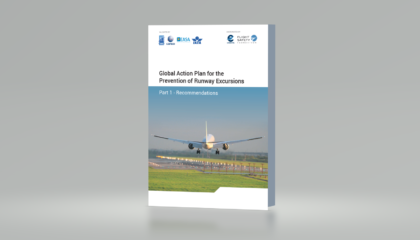
EBAA at safety meetings Q1 2021
In Q1 2021, the EBAA safety team attended various meetings with relevant policymakers and stakeholders. Read an overview of what EBAAs input has been.
Flight Safety Foundation Safety Forum
SAB (Stakeholder Advisory Body) Plenary meeting
The SAB is the strategic and overarching industry advisory body to EASA that contains members from all stakeholder groups in aviation that are within the area of competence of EASA, such as Commercial Air Transport (CAT), General Aviation (GA), Original Equipment Manufacturers (OEM), Air Traffic Control (ATC) etc. This year’s first meeting was, to no surprise, held virtually and consisted of three shorter sessions spread over two days.
During the first session, the various subgroups of the SAB reported on issues they dealt with, current projects and any related actions that required the attention of the SAB plenary.
The following two sessions dealt with the proposed change of Advisory Body structure within EASA, the first one being a discussion between industry representatives and the second being with an EASA representative present.
EASA started a process in late 2020 to change and revise the way the Agency works with the different advisory bodies and subject matter experts, both at the industry and state level. Parts of the new process are looking into how stakeholders, have been working with EASA over the last year. With the exclusive use of virtual meetings, a more efficient way of working has been identified with the aid of technology. Another reason behind this initiative was the ever-increasing need for administrative support to the high number of representatives – close to 900 – involved in various permanent stakeholder groups. The initial proposal was to have only two permanent Advisory Bodies, the SAB, and the MAB (Member State Advisory Body) i.e., Industry and States.
Representatives of the industry have provided input and are continuing to develop suggestions in cooperation with the Member States. These sets of input would assist EASA in improving their efficiency in executing the workplan, while still being transparent and allowing all concerned stakeholders to participate in the development and update of the regulation.
As of yet, there is no final decision on how the advisory body structure will look like but the work should be decided on by mid-2021 and a transition started by end of 2021. In preparation for the new Advisory Body structure, EASA has already started updating their IT infrastructure.
FS.TeC (Flight Standards Technical Committee)
The meeting covered ongoing projects concerning commercial operations, mainly with updates on regulatory changes and tasks to be started in the domain of Air Ops and Air Crew regulation. The restructuring of EASA advisory bodies was presented in brief, as well as the status of COVID19-related exemptions and arising issues in the context of the pandemic e.g. interrupted and expired type ratings. At EBAA’s request, an update was given on the current status regarding regulation for supersonic capable aircraft in Europe. The task has just been started by EASA in two workstreams, certification and AirOps regulation.
CAS.COM (Commercial Aviation Safety Committee)
The European Action Plan for Aviation Safety (EPAS) for 2021-2025 was officially published ahead of the meeting and a briefing on the latest changes was given by EASA. The main task for CAS.COM is to provide industry input on arising safety issues and trends on a more strategic level and thus contribute to the development of the EPAS. The development of EPAS 2021-2025 was, as a consequence of the pandemic, not following any standard cycle. However, the cycle for EPAS 2022-2026 has just started and the intention is to use the normal process that includes a first draft middle of summer 2021.
Of special interest for EBAA are the evaluations of small aeroplane operations (CAT & SPO) tasks that were introduced in EPAS 2021-2025 as EVT.0013, which is scheduled to start in 2023.
Want to get in touch with EBAA about safety? Contact the EBAA Safety team at safety@ebaa.org.




